Deflationary Economic Depression? Where to go from here?
Stock-Markets / Financial Crash Oct 23, 2008 - 12:03 PM GMTBy: John_Lee
 In September two significant events happened that will mark the month as the most financially significant in US history by far
In September two significant events happened that will mark the month as the most financially significant in US history by far
1. Fannie Mae and Freddie Mac were nationalized; this was no surprise as I predicted in November 2007: http://www.goldmau.com..
If left to their own devices by the government, Fannie and Freddie are doomed. At this juncture, the Fed has no choice but to redeem any and all mortgages at near face value directly, through GSEs, or offshore vehicles.
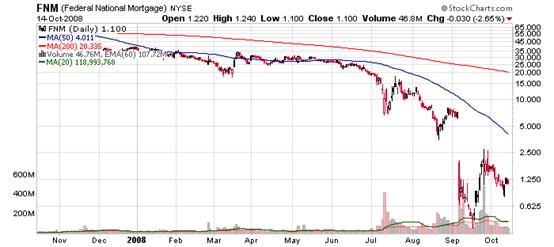
2. Lehman Brothers went under. While I have said all major US banks (including Citibank, and JPMorgan), brokerages (including Goldman Sachs), and big finance companies (AIG, GE, GM, etc) are insolvent, I didn't expect that Lehman would be allowed to go under.
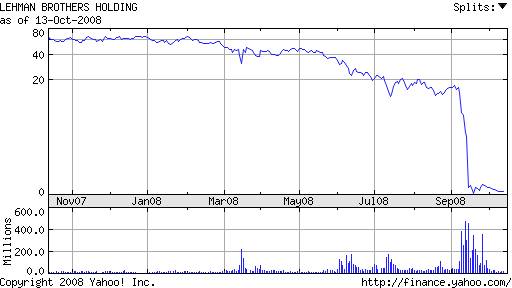
Paulson clearly didn't understand Lehman's involvement. Lehman is a leveraged brokerage shop that was the counterparty to trades sized in the $hundreds of billions, including interest rate swaps, commodity futures, corporate bonds, international equities and real estate loans, currency swaps, and private equities. The counterparty risk created fear and triggered domino selling. Banks refused to lend to one another fearing the other end to be infested with Lehman's positions. Insiders claim that it could take over a decade to fully unwind Lehman's positions.
What's more, Lehman was one of the largest prime brokers to international hedge funds. Lehman's bankruptcy immediately caused wholesale panic within the hedge fund industry as funds tried to close/transfer/pull their money out of their Lehman custodian. Today over $60 billion is still locked up in Lehman's London brokerage unit. Given the leveraging nature of hedge funds, the effect on global equity markets was catastrophic as trillions of dollars were wiped off global equity markets.
Global equity and commodity correction
With $hundreds of billions-worth of positions that need to be closed fast, we witnessed the most dramatic equity downturn outside of 1930 and 1987.
Russian markets went down 70% and Nikkei, the world's second-largest equity index, is down 30% since September 1.
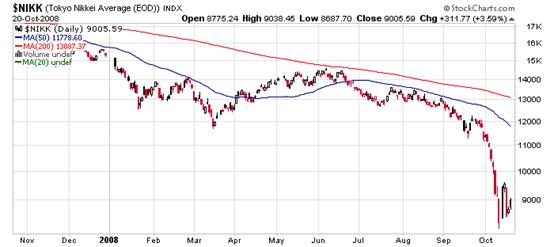
Given that consumer spending accounts for 50 - 70% of GDP across various countries, the equity downturn caused spending pullback and thus global recession talk abounds.
I believe this sudden downturn had more to do with Lehman's derivative positions and hedge funds having locked up than it did with fundamentals.
For example, demand for Oil and Copper had never slacked yet Oil and Copper prices were cut by half in 4 months. Inventory levels remained near historic lows and there was no projected slowdown in commodity demand from China, the world's largest consumer.
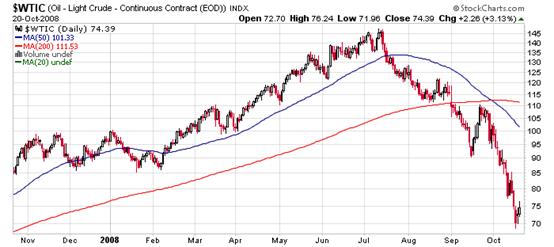
In the financial arena, Chinese, Asian, Middle Eastern, and Latin American banks had minimal exposure to US subprime debt or to the collapse of US banks. The debt level of the Asian consumer, the key driver to the next phase of global growth, remains low.
Commodity Sector
Charts speak more than words.

Coeur D'Alene, world's largest silver producer, is down to 90 cents from $5 in 2008.
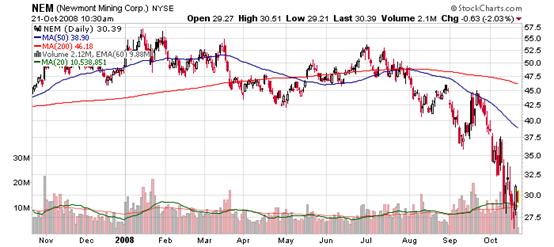
Newmont, world's best known gold producer, is down to $28 from $55 in 2008.
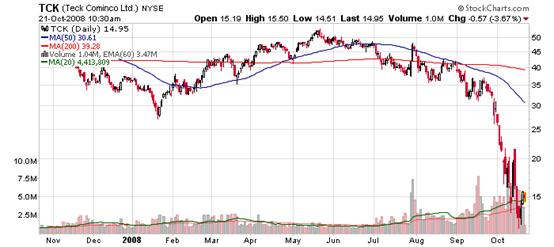
Teck Cominco, Canada's largest mining conglomerate, is down to $15 from a high of $53 in 2008.
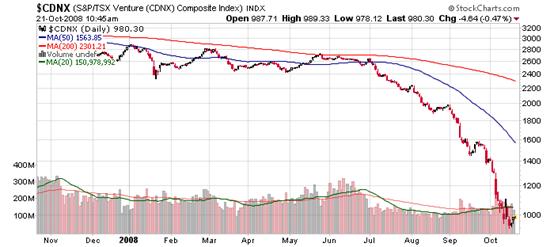
The S&P TSX Ventures Index, a proxy to the junior resource sector, is down 70% to 900, from a high of 3,000 in 2008.
Junior sector and resource funds
In September and October, 2 prominent resource funds closed: Ospraie and RAB. Both combined controlled over $3 billion in the resource junior sector. They literally owned 10-20% of the market and positions had to be sold. We saw classic margin-call selling. Prices of stocks were down 10% on consecutive days with small breaks in between and no rebounds. Many companies soon traded 10%, then 20%, then up to 50% below their bank cash balances. The situation clearly became irrational. Premier gold and silver producers such as Coeur D'Alene and IAMGold were down 50-70% in 2 months.
Where to go from here ?
As of October 20, the junior market looks to have stabilized and I am convinced the correction for quality companies will not last long (i.e. 6 months, less than one year for sure). This is much like the Nasdaq in 2001. Bad companies will go under, while good companies will survive and flourish.
With central banks recently pledging over $2 trillion to solve the crisis, a $750 billion bailout, more consumer stimulus, a federal deficit set to blow over $1 trillion, a continued US trade imbalance, a gigantic $10 trillion foreign reserve that is mostly yet to be diversified, and the central banks' inability to raise rates to combat inflationary pressure, I am more bullish on gold and gold equities than ever. Severe shortages of gold and silver at the retail level across the globe validate my belief that the supply of precious metals is dwindling fast at current prices. Reports from top Swiss vaults state they have "topped up" their metal storage space with no more capacity to spare.
There is talk of a deflationary depression, but my view strongly differs. Firstly, the money supply is exploding so prices will trend up after a brief scare. Secondly, on a global scale, the modernization of Asia and the Middle East is far from over with US $4 trillion at their disposal.
Regardless of the long term picture on gold, when things are selling at 50 cents on the dollar as some stocks are, a brief rebound should see a recovery back to at least cash value. Whenever there is a crisis there is an opportunity.
John Lee, CFA
johnlee@maucapital.com
John Lee is a portfolio manager at Mau Capital Management. He is a CFA charter holder and has degrees in Economics and Engineering from Rice University. He previously studied under Mr. James Turk, a renowned authority on the gold market, and is specialized in investing in junior gold and resource companies. Mr. Lee's articles are frequently cited at major resource websites and a esteemed speaker at several major resource conferences.
John Lee Archive |
© 2005-2022 http://www.MarketOracle.co.uk - The Market Oracle is a FREE Daily Financial Markets Analysis & Forecasting online publication.



